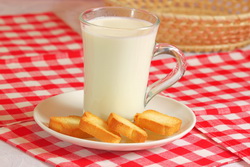Boosting the functional value of milk
Growing consumer awareness regarding a healthy diet and the benefits of functional foods has directed research into the nutritional improvement of natural products like meat and milk. The dairy industry has reinforced its reputation for healthy food by developing lower fat content products with high calcium and vitamin D. One of the latest drives is to increase naturally occurring levels of cis-9, trans-11 conjugated linoleic acid (CLA) in milk. The unsaturated fatty acid CLA is a component of milk, especially when produced organically. Agricultural research centres and commercial dairy concerns have worked together to improve the production of this natural resource under the EU project BIOCLA. Methods of rearing including feeding and management strategies have been investigated to optimise the CLA content of milk. There are two main routes by which CLA is produced in the cow, endogenously in the mammary gland and by biohydrogenation in the rumen. The researchers at MTT Agrifood Research in Finland aimed to quantify the extent of endogenous synthesis of CLA and ascertain its importance in the optimisation of its content. Post-ruminal infusions of the CLA precursor, trans-11, C18:1 and CLA itself were given to dairy cattle. This procedure allowed the scientists to ascertain exactly what percentage of these fatty acids in milk are derived from bioconversion and how much of the precursor is changed to CLA. This was the first study to show the relative importance of endogenous production of CLA by comparison with the ruminal source. Measurement of the proportions of milk fatty acids in response to the infusions confirmed that endogenous synthesis is an important source of CLA in milk. However, giving relatively large supplements of the precursor did not significantly alter the amount of CLA in the mammary gland. This investigation can therefore provide the basis for dairy cattle diet formulation. Any ingredients that would allow an increase in accumulation of CLA precursor or the fatty acid itself in the rumen would be beneficial to the CLA content of the milk. Further research on lipid metabolism in the rumen could be the next step to maximise the health benefits of milk.







